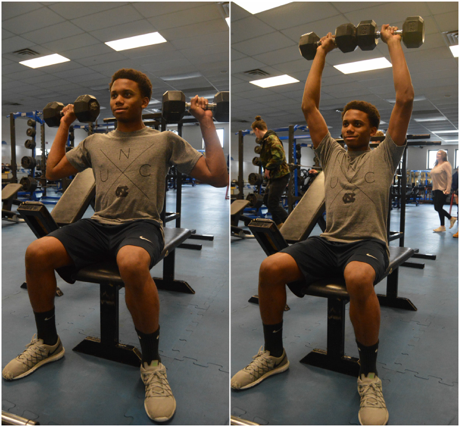Fitness and nutrition tips for healthy living
February 13, 2018
As the holiday season comes to a close, many people are looking to get into better shape and lose some weight. These tips for exercise and nutrition have been scientifically proven to be what works best to make an overall healthier you.
Exercise:
Above, Junior Tyler Myrick-Loveless and Senior Lizzy Zieber demonstrate the exercised that the American Council on Exercise (ACE) has found to cause the most muscle activity.
Exercise has been proven over and over to keep people healthy for longer. According to the Mayo Clinic, a nonprofit organization that uses clinical practice, education, and research to provide expert care to all patients, the benefits of exercise range from better sleep to higher disease resistance.
Exercise is also incredibly beneficial in weight loss, according to the American Council on Exercise (ACE), a nonprofit organization that seeks to improve the quality of life through exercise. In their studies, they looked at which exercises cause the most activity in specific muscles, which can reveal the most effective exercises for that muscle.
In an interview with Men’s Fitness, Jessica Matthews, M.S. and ACE trainer, gave a disclaimer. These exercises cause the most activity but may not be the best exercises to help you achieve your goal, emphasizing the individuality of each exerciser Above all, she warns that, “it’s essential to have a well-rounded routine to train the whole body in one workout.”
Nutrition:
Nutrition plays a big role in living a healthy life. According to the US Department of Health and Human Services (HHS), “combined with physical activity, your diet can help you to reach and maintain a healthy weight, reduce your risk of chronic diseases (like heart disease and cancer), and promote your overall health.”
Unfortunately, many Americans are eating unhealthily which contributes to the US obesity epidemic. HHS says that approximately 33% of American adults and 17% of American children and adolescents are obese. In total, about 54.5 million obese people live in the US.
On top of obesity, there are many bad side effects of eating unhealthy. HHS heart disease, hypertension (high blood pressure), type 2 diabetes, osteoporosis, and certain types of cancer as possible side effects of living an unhealthy lifestyle.
These bad side effects of unhealthy eating have been shown at increasingly younger ages. This is alarming to HHS, because childhood eating habits follow people through to adulthood and can cause major problems in the future.
In order to help people eat healthy, HHS has created a page on how to eat healthy. They encourage people to incorporate six of the eight listed health goals into their lifestyle by committing to one each week for six weeks.
In an effort to promote healthy lifestyles, the HHS has created an eight week program to help combine physical activity and healthy eating. The program, called PALA+, is available for anyone six years old or older and it gives realistic goals for activity levels and dietary restrictions based off of the data someone provides.
In order to complete the program and gain the reward, a certificate detailing the pursuit of a healthy lifestyle, a person will have to meet the 6/9 healthy eating goals and meet the exercise goal for at least 3 weeks. The hope is that people will use this program and get into and continue the habit of a healthy lifestyle.




